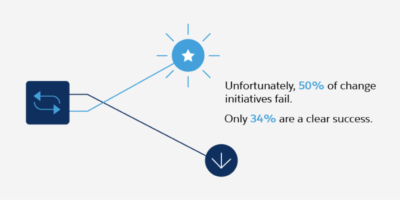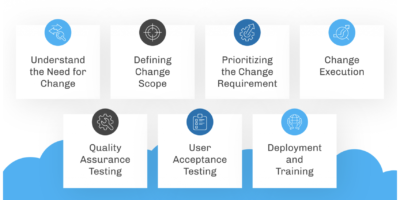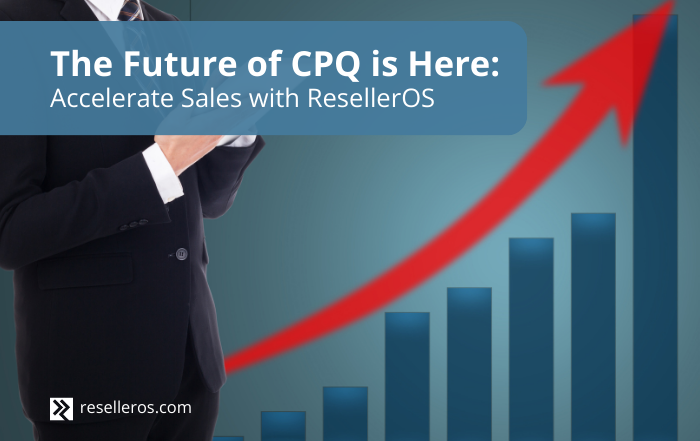How to Perfect Your Change Management Process
The capacity to adapt to ongoing changes is a critical part of long-term business success. Whether it’s unanticipated economic disruption, the rise of new competition, or new technological developments, no business can expect to maintain its successes and continue to grow without developing the ability to change – processes, structures, and technologies – when confronted with the unforeseen. Healthy and robust business models will always include a polished change management process to handle necessary transitions.
Nevertheless, effective implementation of change initiatives typically proves harder than anticipated, with approximately 50% of major structural or operational changes in large organizations failing to meet their objectives and only 34% exhibiting outright success. Moreover, businesses in any industry should only anticipate an increase in major change processes as digital transformation continues to accelerate and as employee standards evolve. In Q4 of 2021, 4.3 million Americans quit their jobs, sending turnover rates into uncharted territory. Reckoning with the causes of the Great Resignation and seizing the opportunity to capture the best and brightest in the recently flooded hiring market will require a strong commitment to adaptability.
In this guide, you’ll learn what change management is and how to create processes for it using Salesforce.

What Is Change Management in Salesforce?
Change management processes are not a one size fits all solution to the challenges of adaptation. The size of an organization, the industry, and external factors such as economic and market conditions all shape the process of planning for change and achieving successful implementation. For example, taking a large enterprise into international markets will require more complex process design and management than deploying new accounting software in a small business.
To help businesses under the subtleties of change management processes and identify core elements, Salesforce breaks down change management into three conceptual categories.
1. Individual Change Management
Individual change management refers to accounting for how changes will affect individual employees and what kinds of psychological reactions new changes might elicit. Another way of putting it would be to say that individual change management asks, “What do individuals in different positions and departments need to fulfill their roles in the change process and thrive on the other side?” The answer will likely involve communication, training, and incentivizing.
2. Organizational Change Management
While individual change management focuses on the needs of specific people, organizational change management addresses more structural concerns. These would likely include changes to processes and operations and the guidelines and workflows governing them. Organizational changes also tend to create a need for new metrics and KPIs to gauge success in unfamiliar territory.
3. Enterprise Change Management
As changes at all scales are inevitable in enterprise environments, enterprise change management involves developing adaptation capacities throughout an extended organization, so everyone affected can prepare, and no one needs to reinvent the wheel periodically. Change management is more of a practiced posture than a one-time process at this level.
7 Steps for Successful Salesforce Change Management
To build adaptability into your corporate culture, there are seven reliable steps organizations of any size and industry can take to improve change management in Salesforce orgs.

1. Understand the Need for Change
In the typical Salesforce org, the need for change may arise periodically for several reasons. You may need to patch a bug or vulnerability, alter a workflow, or merge two or more orgs. At the outset, it is critical to identify the change you need to make, its scale, possible disruptions, and who the change will affect.
2. Define the Scope of Change
Once you’ve identified the need you’re attempting to fulfill, focus on mapping the tasks the change process will require onto the various teams and departments who will carry them out. In larger orgs, knowing the depth of your IT staff is crucial to this phase, as you can easily set processes in motion only to hit technical bottlenecks that your own IT resources may not be ready to handle.
3. Prioritize Change Requirements
When organizational changes involve operational disruptions such as locking out staff of critical systems, it is imperative to let everyone know that hitting change process targets takes top priority over other tasks that aren’t critical during disruptions.
4. Change Execution
Successful change execution requires creating a granular timeline of all necessary tasks and accurately assessing how much time teams need to meet their particular responsibilities. In these workflow timelines, leaders should also make provisions for unexpected delays, defining who moves into different responsibility areas to get things moving.
5. Quality Assurance Testing
Before implementing any Salesforce org change, your organization’s developers must run extensive quality assurance testing in controlled – sandboxed – environments. The stages of sandbox testing typically include:
- Integration Testing
- Functional Testing
- Load Testing
- Security Testing
6. User Acceptance Testing
Testing with end-users should also precede any deployments. Likewise, leaders should schedule user acceptance testing with enough time in advance to allow developers to implement feedback-based adjustments.
7. Deployment and Training
Following end-user feedback, all that remains is to onboard your teams and provide adequate training in changed systems and processes. Detailed planning for deployment and training can eliminate unnecessary downtime following feature rollouts when users don’t understand how to perform the same tasks in redesigned systems or new tasks created by the change.
Salesforce Technological Expertise with Rainmaker
With 18+ years of experience creating technical solutions in the platform, Rainmaker’s team of experts can guide your Salesforce innovation journey while maximizing your organization’s ROI. Offering expertise in fields ranging from manufacturing and government contracting to financial services, Rainmaker can deliver the edge you need.
To learn more, contact Rainmaker today.






